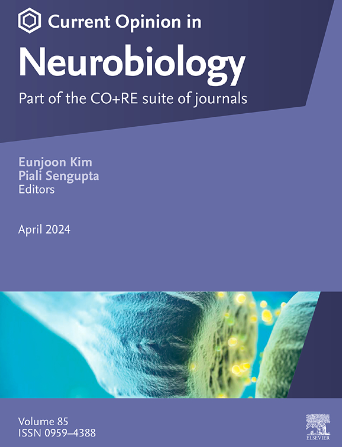New insights into axonal regulators of dopamine transmission in health and disease
IF 5.2
2区 医学
Q1 NEUROSCIENCES
引用次数: 0
Abstract
Dopamine release in the striatum is credited with being critical to the selection and learning of motivated actions and outcomes. Dysregulation of striatal dopamine release underlies multiple disorders of action selection and reward-processing, such as Parkinson’s disease, schizophrenia and addiction disorders, and is a major target for therapeutic interventions. The axonal molecular and circuit mechanisms governing dopamine exocytosis are incompletely resolved, but accumulating evidence suggests some key points of divergence from canonical neurotransmitter synapses. In this review, we bring together recent insights into mechanisms shaping dopamine transmission in the striatum, spanning the molecular machinery regulating exocytosis, striatal modulators locally governing release probability, and the mechanisms regulating dopamine vesicle endocytosis. Together, these findings continue to support points of divergence from canonical presynaptic mechanisms, they inform principles of axonal neuromodulation, and point to potential contributions to the susceptibility to neurodegeneration in Parkinson’s disease.
对健康和疾病中多巴胺传递轴突调节因子的新见解
纹状体中的多巴胺释放被认为对动机行为和结果的选择和学习至关重要。纹状体多巴胺释放失调是多种行为选择和奖励处理障碍的基础,如帕金森病、精神分裂症和成瘾障碍,是治疗干预的主要目标。控制多巴胺胞吐的轴突分子和电路机制尚不完全清楚,但越来越多的证据表明,与典型神经递质突触存在一些关键的分歧。在这篇综述中,我们汇集了最近对纹状体中多巴胺传递机制的见解,包括调节胞吐的分子机制,纹状体调节局部释放概率的机制,以及调节多巴胺囊泡内吞的机制。总之,这些发现继续支持与典型突触前机制的分歧点,它们为轴突神经调节的原理提供了信息,并指出了帕金森病神经变性易感性的潜在贡献。
本文章由计算机程序翻译,如有差异,请以英文原文为准。
求助全文
约1分钟内获得全文
求助全文
来源期刊

Current Opinion in Neurobiology
医学-神经科学
CiteScore
11.10
自引率
1.80%
发文量
130
审稿时长
4-8 weeks
期刊介绍:
Current Opinion in Neurobiology publishes short annotated reviews by leading experts on recent developments in the field of neurobiology. These experts write short reviews describing recent discoveries in this field (in the past 2-5 years), as well as highlighting select individual papers of particular significance.
The journal is thus an important resource allowing researchers and educators to quickly gain an overview and rich understanding of complex and current issues in the field of Neurobiology. The journal takes a unique and valuable approach in focusing each special issue around a topic of scientific and/or societal interest, and then bringing together leading international experts studying that topic, embracing diverse methodologies and perspectives.
Journal Content: The journal consists of 6 issues per year, covering 8 recurring topics every other year in the following categories:
-Neurobiology of Disease-
Neurobiology of Behavior-
Cellular Neuroscience-
Systems Neuroscience-
Developmental Neuroscience-
Neurobiology of Learning and Plasticity-
Molecular Neuroscience-
Computational Neuroscience
 求助内容:
求助内容: 应助结果提醒方式:
应助结果提醒方式:


